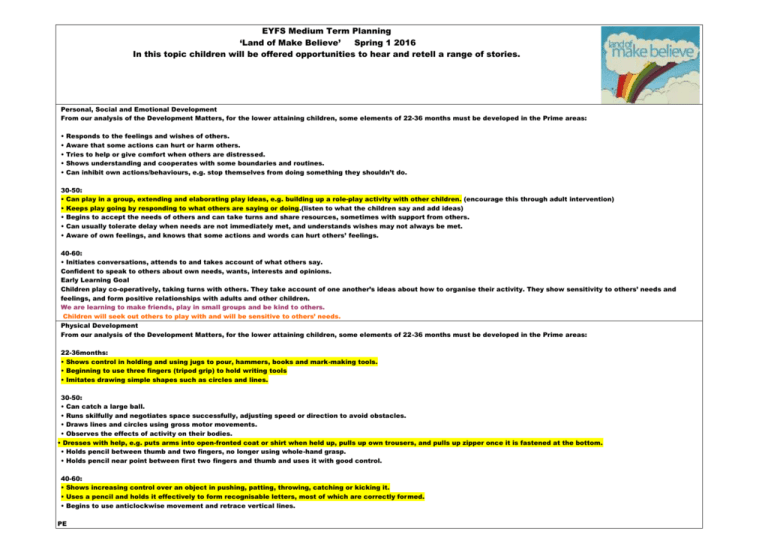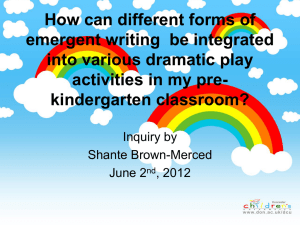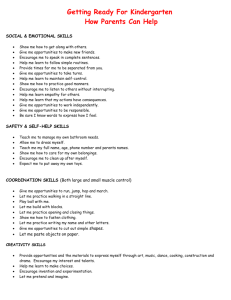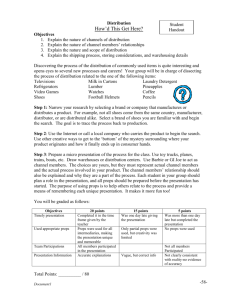Spring 1 Land of Make Believe
advertisement

EYFS Medium Term Planning ‘Land of Make Believe’ Spring 1 2016 In this topic children will be offered opportunities to hear and retell a range of stories. Personal, Social and Emotional Development From our analysis of the Development Matters, for the lower attaining children, some elements of 22-36 months must be developed in the Prime areas: • • • • • Responds to the feelings and wishes of others. Aware that some actions can hurt or harm others. Tries to help or give comfort when others are distressed. Shows understanding and cooperates with some boundaries and routines. Can inhibit own actions/behaviours, e.g. stop themselves from doing something they shouldn’t do. 30-50: • Can play in a group, extending and elaborating play ideas, e.g. building up a role-play activity with other children. (encourage this through adult intervention) • Keeps play going by responding to what others are saying or doing.(listen to what the children say and add ideas) • Begins to accept the needs of others and can take turns and share resources, sometimes with support from others. • Can usually tolerate delay when needs are not immediately met, and understands wishes may not always be met. • Aware of own feelings, and knows that some actions and words can hurt others’ feelings. 40-60: • Initiates conversations, attends to and takes account of what others say. Confident to speak to others about own needs, wants, interests and opinions. Early Learning Goal Children play co-operatively, taking turns with others. They take account of one another’s ideas about how to organise their activity. They show sensitivity to others’ needs and feelings, and form positive relationships with adults and other children. We are learning to make friends, play in small groups and be kind to others. Children will seek out others to play with and will be sensitive to others’ needs. Physical Development From our analysis of the Development Matters, for the lower attaining children, some elements of 22-36 months must be developed in the Prime areas: 22-36months: • Shows control in holding and using jugs to pour, hammers, books and mark-making tools. • Beginning to use three fingers (tripod grip) to hold writing tools • Imitates drawing simple shapes such as circles and lines. 30-50: • Can catch a large ball. • Runs skilfully and negotiates space successfully, adjusting speed or direction to avoid obstacles. • Draws lines and circles using gross motor movements. • Observes the effects of activity on their bodies. • Dresses with help, e.g. puts arms into open-fronted coat or shirt when held up, pulls up own trousers, and pulls up zipper once it is fastened at the bottom. • Holds pencil between thumb and two fingers, no longer using whole-hand grasp. • Holds pencil near point between first two fingers and thumb and uses it with good control. 40-60: • Shows increasing control over an object in pushing, patting, throwing, catching or kicking it. • Uses a pencil and holds it effectively to form recognisable letters, most of which are correctly formed. • Begins to use anticlockwise movement and retrace vertical lines. PE We are learning to negotiate with space and body position. Children will move appropriately and gain more control over themselves and equipment. Handwriting We are learning to hold a pencil correctly and begin to form letters (taught in letter families) Children will begin to make letter like shapes and know the alphabet jingles to ensure correct formation. Communication & Language: From our analysis of the Development Matters, for the lower attaining children, some elements of 22-36 months must be developed in the Prime areas: i.e: children where English is an additional language of communication difficulties: • Uses gestures, sometimes with limited talk, e.g. reaches toward toy, saying ‘I have it’. • Uses a variety of questions (e.g. what, where, who). ELKLAN pg 43-45 • Uses simple sentences (e.g.’ Mummy gonna work.’) Documenting activities through photographs then sequencing those pictures. What happens next? Why? 30-50: Listening & Attention • Joins in with repeated refrains and anticipates key events and phrases in rhymes and stories. Speaking • Beginning to use more complex sentences to link thoughts (e.g. using and, because). • Can retell a simple past event in correct order (e.g. went down slide, hurt finger). • Uses talk to connect ideas, explain what is happening and anticipate what might happen next, recall and relive past experie nces. • Uses a range of tenses (e.g. play, playing, will play, played). Understanding: • Shows understanding of prepositions such as ‘under’, ‘on top’, ‘behind’ by carrying out an action or selecting correct pict ure. 40-60: Listening & Attention • Two-channelled attention – can listen and do for short span. Speaking • Introduces a storyline or narrative into their play. To give instructions Understanding: • Responds to instructions involving a two-part sequence. To follow instructions Children will need to be given opportunities to develop and extend vocabulary through a range of practcal activities. Chatterbox group will support EAL children and those with limited expressive and receptive speech. ‘Chatting with Children’ from ‘I can’ will be used for the Reception children start ing with the Developing Vocabulary activities. Nursery children will access the ‘Toddler talk’ series of activities first. A ‘Tat box’ will be made to enrich receptive language based on our Kirstie Page training course. Also work on barrier games as suggested by CLAS. We are learning to use good talk Children will be given opportunities to explore talking partner work We are learning lots of new words Children will collect words for the Magpie wall and be given opportunities to use new words in storytelling We are learning to retell stores and make up stories of our own We are learning to use words like first, next, after that when we tell a story. Children will be given opportunities to retell a range of stories with props and pictures. Understanding the World Literacy 30-50: • Knows how to operate simple equipment, e.g. turns on CD player and uses remote control. Reading 30-50: • Listens to and joins in with stories and poems, one-to-one and also in small groups. • Joins in with repeated refrains and anticipates key events and phrases in rhymes and stories. • Beginning to be aware of the way stories are structured. • Suggests how the story might end. • Listens to stories with increasing attention and recall. • Describes main story settings, events and principal characters. • Shows interest in illustrations and print in books and print in the environment. 40-60: • Uses ICT hardware to interact with ageappropriate computer software. We are learning to work the CD player to listen to story CD’s and play computer programmes to retell stories. Children will begin to operate ICT equipment independently. 40-60: • Can segment the sounds in simple words and blend them together and knows which letters represent some of them. Writing: 30-50: • Sometimes gives meaning to marks as they draw and paint. 40-60: • Gives meaning to marks they make as they draw, write and paint. • Links sounds to letters, naming and sounding the letters of the alphabet. • Uses some clearly identifiable letters to communicate meaning, representing some sounds correctly and in sequence. • Writes own name and other things such as labels,captions. We are learning to retell stories in our own words. Children will listen to and respond to familiar stories through drawing, sequencing and acting out. Mathematics Expressive Art & Design 30-50: Numbers: • Beginning to represent numbers using fingers, marks on paper or pictures. • Shows an interest in number problems. • Separates a group of three or four objects in different ways, beginning to recognise that the total is still the same. • Compares two groups of objects, saying when they have the same number. • Uses the language of ‘more’ and ‘fewer’ to compare two sets of objects. 30-50: • Uses available resources to create props to support role-play. • Explores and learns how sounds can be changed. Shape, Space & Measure: • Uses shapes appropriately for tasks. We are learning to use our imaginations to tell stories Children will use available props to act out a narrative 40-60: Numbers: • Recognises numerals 1 to 5. • Selects the correct numeral to represent 1 to 5, then 1 to 10 objects. Counts out up to six objects from a larger group. • Counts objects to 10, and beginning to count beyond 10. Uses words like more/less/most/fewest to compare amounts To find the difference between two amounts and to say how many more than/less than. Shape, Space & Measure: • Orders two or three items by length or height. We are learning to represent a number to show many we have in a group Children will be able to count out amounts from larger groups, begin to match the numeral and make marks to represent numerals We are learning to compare amounts Children will be able to find the difference between amouns by lining up and comparing physically or counting on or back on a number track or on or back in their heads. We are learning to talk about the size of different objects. Children will be able to talk about and sort given objects, according to size. 40-60: • Plays cooperatively as part of a group to develop and act out a narrative. • Explores the different sounds of instruments. HIGHLIGHTED AREAS ARE THOSE SKILLS WHICH WILL NEED TO BE EXPLICITLY TAUGHT AND MODELLED FREQUENTLY AND MUST BE REFLECTED IN THE PROVISION ENHANCEMENTS. GREEN AREAS ARE PRIORITY AREAS. Practitioners will work on embedding learning through sensitive interactions during play and encouraging independence and challenge where needed . Area of Learning Enhancements ~ Additional Resources, Visits, Visitors, Displays Resource Implications PSED/CAL/UW/EAD Plan to showcase some of the children’s ‘plays’ in an event ‘Story and Rhyme show’ and coffee morning after assembly on Friday 12th February Costumes, musical instruments. ORDER RESOURCES WITH RADCLIFFE EARLY LANGUAGE GROUP BUDGET CLASS SET OF MUSICAL INSTRUMENTS FOR EYFS Developing communication and extended opportunities to talk ICT LINKS: MOBILE PHONES FROM TES Storysacks for each traditional tale/story PARENT HELPER TO SET UP SOME NEW STORY SACKS Reception: Winter wonderland enhancement to link with seasonal changes. Enhance with Literacy theme phonics and words on fish with fishing rods. Sets of words printed and laminated Stay and Play sessions 6th January CLL Developing language through stories 4th February Maths Exploring numbers and patterns Activities to be confirmed Puppet theatre and props available for storytelling Puppets and props Barrier games CLAS resources Chatterbox activities from I Can ICAN RESOURCE CARDS ORDERED X2 SETS RESOURCE BAGS TO BE MADE TO ACCOMPANY THIS RESOURCE Area of Learning Taken from highlighted areas above... Focused Activities Resource Implications PSED/CAL Retelling a story using a picture book, recalling the events. Retelling a story in a pair or small group Re-enacting a narrative using costumes Re-enacting a narrative using available props and puppets in a larger group Appropriate texts, storyboard images, Time in the provision to coach the children into beijg anle to tell a story. Puppets and props/costumes area to perform. Hotseating the characters in role. Children to ask appropriate questions of the characters Why did you go into the house on your own Goldilocks? What did you sell your cow for Jack? Physical/Literacy Modelling ascribing meaning to marks. Plenty of opportunities for shared writing experiences. Writing messages Modelling the letter formation Writing names daily in Reception through tracing method Planned opportunities for this daily message to read/respond to. Software to show correct formation Letter formation sheets/large paper and chunky markers and chalks outdoors. Name cards to trace CAL UW Maths first Writing names on pictures. Name lists in areas to encourage children to try to copy correctly. Using emergent writing to create labels for models and for pictures. Focus groups of children to develop writing skills in N & Rec Name lists with cursive letters To encourage the use of more complex sentences using ‘and’ and ‘because’. Activities to promote this... Cause and effect pictures. The boy hurt his leg because he had fallen over. The girl ate an ice cream and a cake Using story building games/Rory’s story cubes Reading rhyming books Using rhyming games, silly soup. Slug in a Jug, Rhyming Lotto Pictures and props to link cause and effect. To use appropriate ICT software Making a story map for the Be Bot to travel along Using 2Simple to create a page for a story Using a programme to dress teddy for the weather Investment in ICT equipment and loans from the DTC. Laptops and tablets, explore ICT software and APPS Counting and estimating games using numerals and also capacity. Developing systems for counting. Recognition of numbers and matching numbers to amounts Games to nclude 1 more Number matching jigsaws, pattern making, items of different heights and lengths to create a display/enhamced provision. Estimating and checking games. Investigative games. How many leaves long is the car (linked to Jack & the Beanstalk for example) Investigating sounds table. Can you make a low sound? High sound? Guess my instrument/using barrier. Making our own musical accompaniment ( to replicate sounds in stories e.g: the giants footsteps etc) Using veryday items to make sounds to accompany a story as well as using instruments. Range of musical instruments and old tins, beans, elastic bands, cardboard boxes etc to make instruments. 50 ways to encourage Writing for purpose book (CH’s own) Games, books, sequencing pictures Rhyming stories and games EAD KEY: Bullet points in black refer to development matters and are taken directly from the EYFS 2012 ‘We are learning to’ refers to the learning objective in child speak. ‘Children will’ refers to what the learning will look like in action in the setting.







